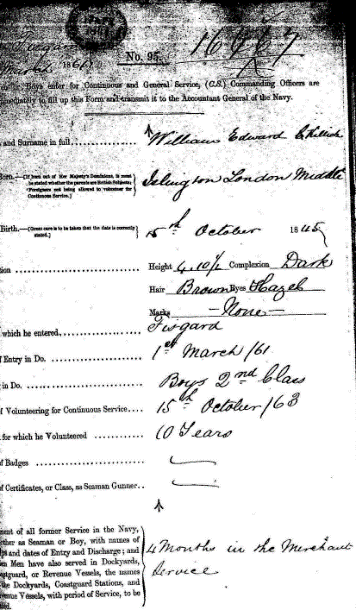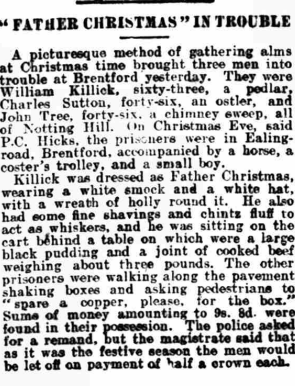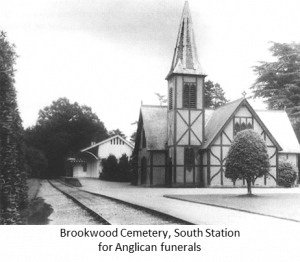WILLIAM AND ELLEN KILLICK
Subject Names : William Killick (b1845 – d1916)
Ellen Killick (b ca1852 – d1911)
Researcher : Mike Brock
William and Ellen Killick led an itinerant lifestyle which saw them appear in a string of workhouses across southern England. They settled for a time in West London where William was arrested begging for money dressed as Father Christmas.
William Edward Killick was born on 15th October 1845 at 4 York Place, Barnsbury Park, Islington, the son of Thomas and Margaret Killick née Cotton. His baptism on 16th November, however, took place in West London at the church where his parents had married in 1836, St John’s in Hyde Park, Paddington.
William’s father Thomas had been a soldier in the Grenadier Guards, then a bricklayer, but was by 1845  working at the newly opened Pentonville Prison in Caledonian Road, Islington. This did not last, as by the time of the 1851 Census, 42-year-old Thomas was a stoker, probably for the General Post Office (GPO). The family had also moved a short distance to 5 Witchampton Street, Hoxton. William, age 5, had four siblings – Margaret (9), Henry (7), Edward (2) and Catherine (1). Their mother Margaret was 37.
working at the newly opened Pentonville Prison in Caledonian Road, Islington. This did not last, as by the time of the 1851 Census, 42-year-old Thomas was a stoker, probably for the General Post Office (GPO). The family had also moved a short distance to 5 Witchampton Street, Hoxton. William, age 5, had four siblings – Margaret (9), Henry (7), Edward (2) and Catherine (1). Their mother Margaret was 37.
On 25th September 1860, William, just before his 15th birthday, signed up for a five-year term as an apprentice in the Merchant Navy. He was assigned to the small Goole-registered sailing ship “Unity”, ![]() which had arrived in London four days earlier from Caen, on the north coast of France. The Unity traded between Caen and south east England. His older brother Henry, 16, also signed up for the Merchant Navy for a four-year apprenticeship the following month.
which had arrived in London four days earlier from Caen, on the north coast of France. The Unity traded between Caen and south east England. His older brother Henry, 16, also signed up for the Merchant Navy for a four-year apprenticeship the following month.
 However, neither of the boys completed their term of service in the Merchant Navy. Continuing to plot together, on 1st March 1861 William and Henry both signed up for the Royal Navy, for 10 years’ service which would be calculated from their 18th birthdays. When 15-year-old William enlisted, he was accepted as a “Boy, 2nd class” which would involve him being based initially on the training ship HMS Fisgard at Woolwich, Kent. His record noted he had completed just four months in the Merchant Navy. William was 4 feet 10 ½ inches tall (1.49m) with brown hair, hazel eyes and a dark complexion. Henry signed up as a “Boy, 1st class” and would have joined William on Fisgard for training.
However, neither of the boys completed their term of service in the Merchant Navy. Continuing to plot together, on 1st March 1861 William and Henry both signed up for the Royal Navy, for 10 years’ service which would be calculated from their 18th birthdays. When 15-year-old William enlisted, he was accepted as a “Boy, 2nd class” which would involve him being based initially on the training ship HMS Fisgard at Woolwich, Kent. His record noted he had completed just four months in the Merchant Navy. William was 4 feet 10 ½ inches tall (1.49m) with brown hair, hazel eyes and a dark complexion. Henry signed up as a “Boy, 1st class” and would have joined William on Fisgard for training.
Unusually, the available service records give no further details, so it is not known if they completed, or even started, their service in the Royal Navy. Henry reappeared in Bermondsey, Surrey, marrying in 1872 going on to raise a large family there.
So where did William go? There was clearly a wanderlust gene in the family, as his sister Margaret emigrated to New Zealand in 1875 with her husband Charles Robert Heath and daughter. A year later, William’s younger brother Frederick went to New Zealand as well with his wife Emma and two children. It even seems that his mother emigrated, with a 56-year-old widow Margaret Killick noted as sailing to Melbourne, Australia, also in 1875. His father Thomas had passed away in the Surrey County Asylum, Wandsworth, in 1866, age 56.
However, it appears that William remained at home, as the first record found for him since he signed up for the Royal Navy in 1861 was his admission to the Broad Street Holborn Workhouse in central London on 4th February 1878. 31-year-old biscuit maker William was accompanied by his 25-year-old wife Ellen. The record said they had entered the Workhouse by their own request and left five days later. On 18th February, they admitted themselves again to Broad Street before leaving of their own accord on 2nd March.
Whether William and Ellen were actually married is unknown. The 1911 Census gives the only clue, in which William wrote that they had been married for 34 years. This would date their marriage to shortly before their appearance in Broad Street, but no British or overseas marriage record has been found for them. This means that there is no record of Ellen’s maiden name, so apart from knowing that she was born in Holborn around 1852, it has not been possible to trace her family. William also wrote in the 1911 Census that they had had four children, but that none of them were alive by that time. Again, no trace has been found of any of their lives.
A month after leaving the Broad Street Workhouse, William and Ellen walked into the Hoo Union Workhouse, near Rochester, Kent, about 55km (35 miles) away from Holborn. They left on 7th May.
William appeared on a Census record for the first time in 30 years when the 1881 Census of 3rd April showed him with Ellen in the Guildford Union Workhouse. They were noted as “vagrants”, with William a 36-year-old baker born in St Pancras and wife Ellen, 27, born in Holborn. There are no records to show when they entered or departed the Guildford Union, but a year later on the 14th June 1882 they were back in Kent, at the Medway Union Workhouse in Chatham. William, a “labourer”, was noted as being ill, but six days later he was seemingly recovered as they left the Workhouse of their own request. Ellen’s occupation was put as “fieldwork”, so maybe the couple were earning money here and there.
Another 19 years passes before either of them are traced again and the result is somewhat surprising as the 1901 Census shows William, 54, a hawker, and Ellen, 47, a charwoman, apparently settled, living at 38 St Ann’s Road, Kensington. This was close to where the White City Stadium was to be built six years later, and where the 1908 London Olympic Games were staged. It was certainly not a life of luxury living there, though – William and Ellen had 12 other people from five different families under the same roof as them.
 On Christmas Eve following the London Olympics, William, age 63, was arrested with two other men after William dressed up as Father Christmas to go begging in Ealing Road, Brentford. Accompanied by a horse, a costermonger’s trolley and a small boy, William wore a white smock and a white hat with a wreath of holly around it while sporting a beard made of shavings and chintz fluff. He sat on the trolley behind a table on which was a black pudding and a large joint of roast beef, while the two men walked among the crowd, shaking boxes and asking, “spare a copper please, for the box”. When they were arrested, they were found to have collected 9s 8d (46p, worth roughly £50 as at February 2023). The police wished the trio to be held on remand, but the magistrate was in a festive mood, letting them off with half a crown (12.5p) fine each, seemingly leaving them with a small profit!
On Christmas Eve following the London Olympics, William, age 63, was arrested with two other men after William dressed up as Father Christmas to go begging in Ealing Road, Brentford. Accompanied by a horse, a costermonger’s trolley and a small boy, William wore a white smock and a white hat with a wreath of holly around it while sporting a beard made of shavings and chintz fluff. He sat on the trolley behind a table on which was a black pudding and a large joint of roast beef, while the two men walked among the crowd, shaking boxes and asking, “spare a copper please, for the box”. When they were arrested, they were found to have collected 9s 8d (46p, worth roughly £50 as at February 2023). The police wished the trio to be held on remand, but the magistrate was in a festive mood, letting them off with half a crown (12.5p) fine each, seemingly leaving them with a small profit!
Rather more seriously, on 28th February 1911, William was taken into custody again, charged  with “placing himself in Mill Hill Road, Acton, to beg or receive alms”. At 10.40 that morning, he had been found there singing and receiving money from passers-by. In court, William, 65, said that he was unable to get employment, and had started singing a little “to obtain a little nourishment” for his wife, who was not well. He said that he had been living in the same house for 24 years. Although this was not strictly true, as he gave his address as 11 Lockton Street, Notting Hill (just a 2-minute walk from his previous home in St Ann’s Road), his story was believed. It could indicate that William and Ellen first lived in St Ann’s Road around 1897.
with “placing himself in Mill Hill Road, Acton, to beg or receive alms”. At 10.40 that morning, he had been found there singing and receiving money from passers-by. In court, William, 65, said that he was unable to get employment, and had started singing a little “to obtain a little nourishment” for his wife, who was not well. He said that he had been living in the same house for 24 years. Although this was not strictly true, as he gave his address as 11 Lockton Street, Notting Hill (just a 2-minute walk from his previous home in St Ann’s Road), his story was believed. It could indicate that William and Ellen first lived in St Ann’s Road around 1897.
The 1911 Census just over a month later confirmed that William, 66, a costermonger, and Ellen, 55 (probably 59), were at 11 Lockton Street, living in just one room of the building. In all, there were five separate families living there, each with one room – a total of 14 people in five rooms, so a very similar situation to their previous home.
Ellen’s illness was also shown to be true, as on 6th October 1911, she passed away at home age 60 from “premature senile decay & bronchitis”.
Sometime following Ellen’s death, William left West London and began to appear in workhouses again. The first record found is for 7th April 1915 when he was admitted to the Medway Union Workhouse, Chatham. He was described as a hawker, age 70, not able bodied and requiring an infirm diet. He left the workhouse on 4th July at his own request with no apparent change in his condition.
Despite his failing health, he continued to roam the streets, but 18 months later he died on 23rd November 1916 age 70 of “pyloric and hepatic carcinoma” in Bermondsey Infirmary, Rotherhithe, having been previously at the Dartford Union Workhouse.
William’s burial was at Brookwood Cemetery, Woking on 1st December, nearly 50km from where he had died.
Back in the mid-19th Century, it was realised the space in London cemeteries was rapidly running out, so Brookwood Cemetery was established in 1854 to help deal with this problem. The cemetery, the world’s largest at that time with 2,000 acres, was situated alongside the South-Western Railway running from Waterloo Station to Southampton. A separate station was built adjacent to Waterloo by the London Necropolis and National Mausoleum Company, purely to  transport coffins and grieving relatives. This station was closed in 1902 following the expansion of Waterloo, so the service continued from nearby Westminster Bridge Road which is where William’s coffin would have commenced its journey. From Brookwood Station, a branch line ran into the cemetery’s grounds with two stations for either non-conformist or Anglican burials. At its peak, an estimated 2,000 coffins per day were transported to Brookwood. The service was discontinued after 87 years when a Luftwaffe bombing raid severely damaged the London station on 16-17th April 1941, forcing it to close.
transport coffins and grieving relatives. This station was closed in 1902 following the expansion of Waterloo, so the service continued from nearby Westminster Bridge Road which is where William’s coffin would have commenced its journey. From Brookwood Station, a branch line ran into the cemetery’s grounds with two stations for either non-conformist or Anglican burials. At its peak, an estimated 2,000 coffins per day were transported to Brookwood. The service was discontinued after 87 years when a Luftwaffe bombing raid severely damaged the London station on 16-17th April 1941, forcing it to close.
April 2023
Sources
Ancestry.co.uk
Bankofengland.co.uk
Deceasedonline.com
Encyclopedia Britannica Kids.Britannica.com
FamilySearch.org.uk
FindMyPast.co.uk / British Newspaper Archive
General Register Office GRO.gov.uk
HistoryToday.com
RobsLondon.com
SouthWesternRailway.com
The National Archives Discovery.nationalarchives.gov.uk
En.Wikipedia.org
For a full list of references click here
